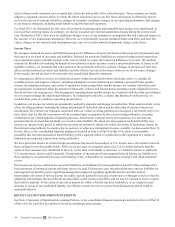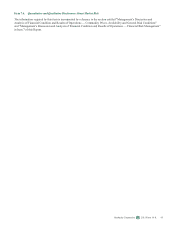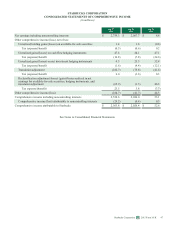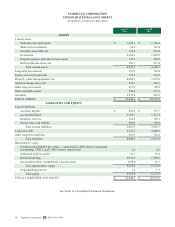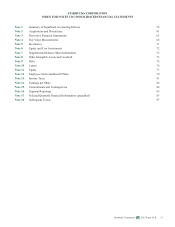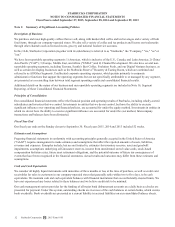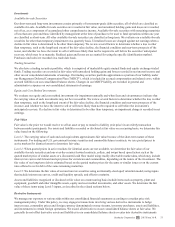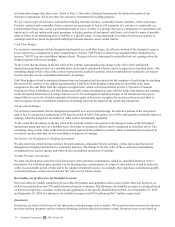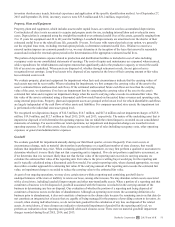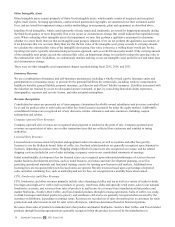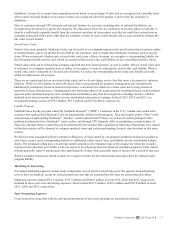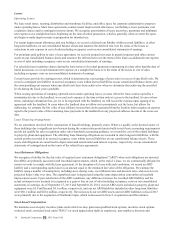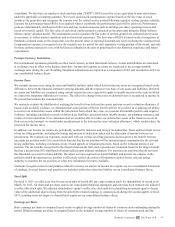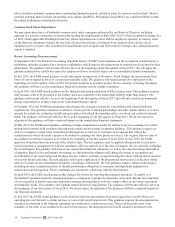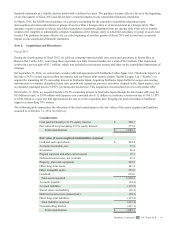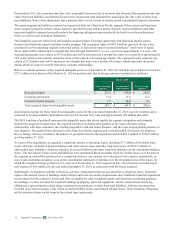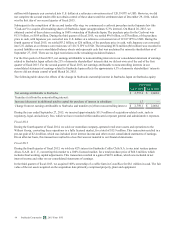Starbucks 2015 Annual Report Download - page 58
Download and view the complete annual report
Please find page 58 of the 2015 Starbucks annual report below. You can navigate through the pages in the report by either clicking on the pages listed below, or by using the keyword search tool below to find specific information within the annual report.
with maturities longer than three years. Refer to Note 3, Derivative Financial Instruments, for further discussion of our
derivative instruments. We do not enter into derivative instruments for trading purposes.
We use various types of derivative instruments including forward contracts, commodity futures contracts, collars and swaps.
Forward contracts and commodity futures contracts are agreements to buy or sell a quantity of a currency or commodity at a
predetermined future date, and at a predetermined rate or price. A collar is a strategy that uses a combination of a purchased call
option and a sold put option with equal premiums to hedge a portion of anticipated cash flows, or to limit the range of possible
gains or losses on an underlying asset or liability to a specific range. A swap agreement is a contract between two parties to
exchange cash flows based on specified underlying notional amounts, assets and/or indices.
Cash Flow Hedges
For derivative instruments that are designated and qualify as a cash flow hedge, the effective portion of the derivative's gain or
loss is reported as a component of other comprehensive income ("OCI") and recorded in accumulated other comprehensive
income ("AOCI") on our consolidated balance sheets. The gain or loss is subsequently reclassified into net earnings when the
hedged exposure affects net earnings.
To the extent that the change in the fair value of the contract corresponds to the change in the value of the anticipated
transaction using forward rates on a monthly basis, the hedge is considered effective and is recognized as described above. The
remaining change in fair value of the contract represents the ineffective portion, which is immediately recorded in net interest
income and other on our consolidated statements of earnings.
Cash flow hedges related to anticipated transactions are designated and documented at the inception of each hedge by matching
the terms of the contract to the underlying transaction. Cash flows from hedging transactions are classified in the same
categories as the cash flows from the respective hedged items, which is discussed further at Note 3, Derivative Financial
Instruments. Once established, cash flow hedges generally remain designated as such until the hedge item impacts net earnings,
or the anticipated transaction is no longer likely to occur. For dedesignated cash flow hedges or for transactions that are no
longer likely to occur, the related accumulated derivative gains or losses are recognized in net interest income and other or
interest expense on our consolidated statements of earnings based on the nature of the underlying transaction.
Net Investment Hedges
For derivative instruments that are designated and qualify as a net investment hedge, the effective portion of the derivative's
gain or loss is reported as a component of OCI and recorded in AOCI. The gain or loss will be subsequently reclassified into net
earnings when the hedged net investment is either sold or substantially liquidated.
To the extent that the change in the fair value of the forward contract corresponds to the change in value of the anticipated
transactions using spot rates on a monthly basis, the hedge is considered effective and is recognized as described above. The
remaining change in fair value of the forward contract represents the ineffective portion, which is immediately recognized in
net interest income and other on our consolidated statements of earnings.
Derivatives Not Designated As Hedging Instruments
We also enter into certain foreign currency forward contracts, commodity futures contracts, collars and swaps that are not
designated as hedging instruments for accounting purposes. The change in the fair value of these contracts is immediately
recognized in net interest income and other on our consolidated statements of earnings.
Normal Purchase Normal Sale
We enter into fixed-price and price-to-be-fixed green coffee purchase commitments, which are described further at Note 5,
Inventories. For both fixed-price and price-to-be-fixed purchase commitments, we expect to take delivery of and to utilize the
coffee in a reasonable period of time and in the conduct of normal business. Accordingly, these purchase commitments qualify
as normal purchases and are not recorded at fair value on our balance sheets.
Receivables, net of Allowance for Doubtful Accounts
Our receivables are mainly comprised of receivables for product and equipment sales to and royalties from our licensees, as
well as receivables from our CPG and foodservice business customers. Our allowance for doubtful accounts is calculated based
on historical experience, customer credit risk and application of the specific identification method. As of September 27, 2015
and September 28, 2014, the allowance for doubtful accounts was $10.8 million and $6.7 million, respectively.
Inventories
Inventories are stated at the lower of cost (primarily moving average cost) or market. We record inventory reserves for obsolete
and slow-moving inventory and for estimated shrinkage between physical inventory counts. Inventory reserves are based on
54 Starbucks Corporation 2015 Form 10-K


